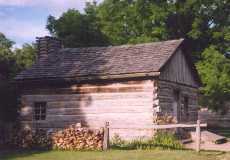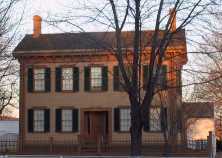Home | News | Books | Speeches | Places | Resources | Education | Timelines | Index | Search
© Abraham Lincoln Online
© Abraham Lincoln Online
© Abraham Lincoln OnlinePlaces Where Abraham Lincoln Lived
These buildings represent the seasons of Lincoln's life: a small log cabin recalling his youth, the upper-middle-class house he owned in Illinois, and the White House where he spent four uneasy years. The first half of his life he spent in log cabins or similar structures. Throughout his lifetime he moved often, even when travel was difficult at best. Now most of the structures he knew are long lost to history but some have been preserved and are open to visitors. The following summary offers a brief glimpse of his past through the places he called home.February 12, 1809 -- Spring 1811
Sinking Spring Farm -- Lincoln was the first son born to Thomas and Nancy Hanks Lincoln, who were already parents of a two-year-old daughter. They lived on a 300-acre farm by the south fork of Nolin Creek near Hodgenville, Kentucky. The name arose from a cave-fed spring still visible on the property today. Now managed by the National Park Service, the remains of the farm are accessible from U.S. Highway 31E. The original one-room Lincoln cabin has disappeared, but a replica stands inside a much-visited stone memorial building.
Spring 1811 -- December 1816
Knob Creek Farm -- When Lincoln was two years old, his family moved nine miles down the road to a farm named for the creek running through the land and its characteristic knob-shaped hills. Thomas, the youngest child, was born here when Lincoln was three, but died soon afterward. In 1860 Lincoln wrote that his earliest recollection was of this place. The National Park Service maintains the farm area on U.S. Route 31E near Hodgenville, Kentucky, which includes a reconstructed cabin.
December 1816 -- March 1, 1830
Pigeon Creek Farm -- Because of disputed titles to his Kentucky land, Lincoln's father moved his family to the wilderness of Spencer County, Indiana. An aunt, uncle and nephew of Lincoln's mother joined them later. However, by 1818 Lincoln's mother and her aunt and uncle died of a sudden illness. His father remarried the next year, bringing a kind stepmother and her three children into the tiny cabin. In 1826 Lincoln's sister married, only to die in childbirth 15 months later. Once again, Lincoln's father decided to move on. Only the foundation of a Lincoln cabin remains in Indiana. The National Park Service maintains the homestead property and its living history farm as the Lincoln Boyhood National Memorial.
March 14, 1830 -- March 1, 1831
Lincoln Trail Homestead -- After traveling from southern Indiana by ox-cart teams, Lincoln and his extended family erected a homestead 10 miles west of Decatur in central Illinois. This plot on the north side of the Sangamon River was excellent farmland, but illness and an extremely harsh winter prompted them to move to Coles County after only one year. Lincoln parted ways with his father and stepmother here at age 22 to take cargo down the Mississippi River and seek his fortune. The small state park memorializing the now-vanished homestead lies south of Route 36.
July 1831 -- April 15, 1837
New Salem -- After returning from New Orleans, Lincoln settled in this pioneer village northwest of Springfield, Illinois. He boarded with various families and took odd jobs while teaching himself grammar, surveying, and other subjects. After a stint in the state militia he studied law, became elected to the state legislature and spent a few months of the year in Vandalia, the state capital. After helping to move the capital to Springfield, he began his legal career there. The New Salem site is now a state park but most of the log homes are not original. The Vandalia state house has been restored and is open to visitors, but Lincoln's lodgings were not preserved.
April 15, 1837 - February 11, 1861
Springfield -- When Lincoln arrived in the new capital of Illinois, he boarded with friends and stayed in country inns and farmhouses while traveling the legal circuit, which covered several counties. After he married Mary Todd in November 1842, they lived briefly at the Globe Tavern, which is no longer standing, where Robert, their first son was born. In the fall of 1843 they rented a small home at 214 South Fourth Street, which no longer exists. By May 1844 they purchased a house at Eighth and Jackson Streets, now a beloved visitors' site. Here three of their four sons were born and one, Edward Baker Lincoln, died.
The Lincolns also lived in a boarding house in Washington during his term in Congress; the Library of Congress Jefferson Building now occupies the site. They rented their Springfield home to Cornelius Ludlum and later to Mason Brayman (November 1, 1847 - March 31, 1849). When Lincoln was elected President, he leased the house to Lucian Tilton, president of the Great Western Railroad, who remained there until May 1, 1869, four years after Lincoln's death. President-elect Lincoln vacated the house a few days before leaving town on February 11, 1861, when he boarded a train at the nearby Great Western depot.
February 23, 1861 - April 14, 1865
Washington, DC -- Following a long inaugural journey, the Lincoln family stayed briefly in the Willard Hotel, a few blocks east of the White House. After President Lincoln's inauguration on March 4, 1861, they lived on the second floor of the White House. Robert Lincoln attended Harvard College and was seldom present, but the remaining sons, Willie and Thomas (Tad), lived in the presidential quarters. Willie died there in 1862, so his remains and that of his murdered father returned together to Illinois in 1865.
During the summers of 1862-64, the family spent time on the grounds of the Soldiers' Home, now a military retirement facility several miles north of the White House. This location gave them more peace and privacy, yet was close enough for President Lincoln to commute to his office by horseback or carriage. The house they used is now open to the public as the Lincoln Cottage.
Home | News | Education | Timelines | Places | Resources | Books | Speeches | Index | Search Text and photos copyright © 2019 Abraham Lincoln Online. All rights reserved. Privacy Policy



